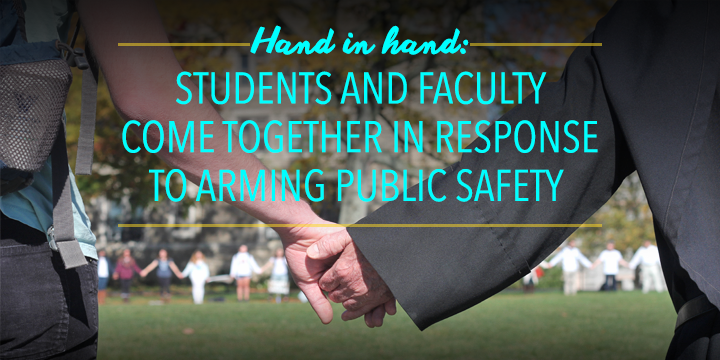Hand in hand: Students and Faculty Come Together in Response to Arming Public Safety
October 27, 2015
The administration’s decision to arm public safety was challenged on Friday when 150 students, faculty and staff staged a peaceful protest. The protestors marched in silence from Saint Thomas of Villanova Church to the Oreo, where students encircled the Ellipse. The demonstration lasted a little over half an hour and was concluded with speeches about the group’s concerns. The protesters were not a part of any formal organization on campus, but organized via social media.
The march was in response to an announcement made by the University on Monday, Oct. 19. In an email to students, the University President, Rev. Peter M. Donohue, O.S.A., PhD. revealed that armed police officers will be added to the public safety department starting in the fall of 2016. Donohue assured students that this decision was made with input from the community, through surveys and forums that took place in December of 2013. The University also hired an independent consultant to evaluate campus security. But the protesters were unsatisfied.
“We did not see the results of the survey,” junior Matt Zarenkiewicz said. “We did not see the results of the task force. We didn’t see the results of the third party consultation. There’s been no transparency. It felt like they were just trying to placate us.”
During the demonstration, Zarenkiewicz read aloud a letter that the protesters had sent to Donohue on Wednesday, Oct. 21. In the letter, the students asked for greater transparency and more student involvement in the decision.
They pointed out that freshmen and sophomores were not at the University at the time the surveys were given. The decision contradicts a resolution against the arming of public safety passed by the Faculty Congress in October of 2013. Donohue did not comment on the protest, but agreed to meet with the students.
Many students at the march felt the decision was an extreme reaction to the Oct. 5 threat. “There weren’t enough measures put in place to protect the campus before deciding to arm public safety, like having check points on campus,” said Gabriela Puche, who participated in the march.
Senior Cece Franko agreed. “I feel that the administration made the decision based on the fear of students and parents without really getting everyone’s opinions,” she said. Other universities have mass shooting drills. Knowing how to act in an active shooter situation would make me feel more safe.”
The protest made local news with ABC, FOX and the Inquirer, and caught the attention of many alumni.
But not all students are against the decision. “I think it’s the right move,” freshman Matt Wegrzyn said. The threat made a lot of people feel unsafe. Students wanted someone on campus who could protect us and had the means to do so.”
The protesters’ ultimate goal is to have the decision repealed. To further discussion, they held an open forum on Monday, where all were welcome to voice their opinions.
“I don’t think that decisions are final at Villanova,” Father Joe Calderoni, O.S.A. said. “We’re not a dictatorship; we’re a community. If the decision is going to remain unchanged, the administration will have to have very good reasons.”
More than 100 students, faculty and alumni packed Mendel’s largest lecture hall for a forum on the recent decision arm a percentage of Villanova’s public safety department. The Association for Change and Transformation (ACT) publicized the even on Facebook with a post that read, “Whether you agree or disagree on the decision, we encourage you to engage in meaningful dialogue on the topic; this controversy is far from over.”
Moderators included three undergraduate students and two professors: Dr. Allison Payne of the Honors and Criminology Department and Dr. Timothy Horner of the Center for Peace and Justice Education.
Horner began the forum with information on the Presidential Task Force composed of faculty, staff and students to research and discuss the decision. After months of deliberation the assembly recommended that Public Safety be sworn and unarmed. A member of the task force, Horner expressed his frustration that the recommendation was ignored, and the report submitted by the task force has not been published to the Villanova Community. Payne took the floor next, discussing her opinion as a specialist in school security. Payne emphasized that there is no current research conducted on the effect of police on college campuses. Thus, all speculations as to these effects must be extrapolated from research conducted in high schools and lower levels of education.
A student panelist provided “The ACT’s narrative,” explaining that the narrative articulated in Donahue’s email is not the only narrative. Following a short review of the rules of engagement for respectful dialogue, the floor was opened to audience participation.
Students with the desire to comment raised their hands and were called upon, by name, by a student panelist. One or both faculty moderators responded to every comment, alternatively answering questions and offering opinion. Dialogue between students was disallowed, and not all hands were addressed in the time devoted to open discussion.
Several contributions were affirmed by the snapping of fingers in the audience. Other comments were met with animated facial expressions by panelists depicting positive and negative reactions. A large part of dialogue was dedicated to race relations, while other comments addressed sexual assault, community impact and alternative solutions.
ACT plans to hold a follow-up forum in order to establish the next steps of this movement. Students who organized Friday’s protest will have an audience with Donahue.
ACT restricted the forum from all outside media sources and the Villanovan was unable to record direct quotes from audient participants.











